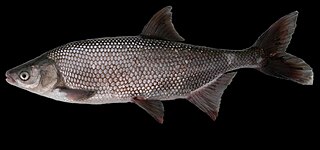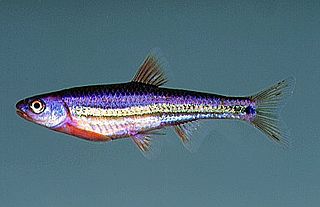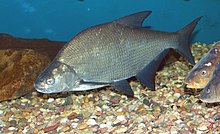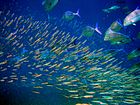
Cyprinidae is a family of freshwater fish commonly called the carp or minnow family, including the carps, the true minnows, and their relatives the barbs and barbels, among others. Cyprinidae is the largest and most diverse fish family, and the largest vertebrate animal family overall, with about 3,000 species; only 1,270 of these remain extant, divided into about 200 valid genera. Cyprinids range from about 12 mm in size to the 3 m (9.8 ft) giant barb. By genus and species count, the family makes up more than two-thirds of the ostariophysian order Cypriniformes. The family name is derived from the Greek word kyprînos.

Cypriniformes is an order of ray-finned fish, including the carps, minnows, loaches, and relatives. Cypriniformes is an Order within the Superorder Ostariophysi consisting of "Carp-like" Ostariophysins. This order contains 11-12 families, although some authorities have designated as many as 23, over 400 genera, and more than 4,250 species, with new species being described every few months or so, and new genera being recognized frequently. They are most diverse in southeastern Asia, and are entirely absent from Australia and South America. At 112 years old, the longest-lived cypriniform fish documented is the bigmouth buffalo.
A dace is a small fish that can be one of many different species. The unmodified name is usually a reference to the common dace. This, like most fish called "daces", belongs to the family Cyprinidae, mostly in subfamily Leuciscinae.

Phoxinus is a genus of freshwater fish in the family Leuciscidae of order Cypriniformes, and the only members of the subfamily Phoxininae, or Eurasian minnows. The type species is Phoxinus phoxinus. The other species in this genus are also commonly known as minnows. The name "minnow" was what early English fisherman used to describe "small and insignificant". The genus Phoxinus is found throughout Eurasia, and includes 21 known species. Previously, members of the North American genus Chrosomus were also believed to form part of this genus.

Rhinichthys, known as the riffle daces, is a genus of freshwater fish in the carp family (Cyprinidae) of the order Cypriniformes. The type species is Rhinichthys atratulus, the blacknose dace. Rhinichthys species range throughout North America.

Dionda is the genus of desert minnows, small fish belonging to the family Cyprinidae. They are native to fresh waters in the United States and Mexico. Their range is centered in the Rio Grande basin, but they also occur in associated systems, including Nazas–Aguanaval of north–central Mexico, and Nueces, San Antonio and Colorado of Texas.

The hitch is a cyprinid fish endemic to central California, and was once very common. The common name may derive from a Pomoan word for this species. It is the only species in the monospecific genus Lavinia.

Notropis is a genus of freshwater fish in the family Cyprinidae. They are known commonly as eastern shiners. They are native to North America, and are the continent's second largest genus.

Chondrostoma is a genus of ray-finned fish in the family Cyprinidae. They are commonly known as nases, although this term is also used locally to denote particular species, most frequently the common nase . The common name refers to the protruding upper jaw of these fishes; it is derived from the German term Nase 'nose'.
Chondrostoma holmwoodii, sometimes known as the Izmir nase or Eastern Aegean nase, is a species of ray-finned fish in the family Cyprinidae. It is endemic to Western Turkey. The specific name holmwoodii honours Frederic Holmwood, collector of the holotype and British consul-general at what then was Smyrna.

Cyprinella is a genus of fish in the family Cyprinidae, the carps and minnows. They are known as the satinfin shiners. They are native to North America, and some are among the most common freshwater fish species on the eastern side of the continent. Conversely, several Cyprinella species with small distributions are threatened and the Maravillas Creek subspecies of the red shiner is extinct.
Squalius is a genus of fish in the family Cyprinidae found in Europe and Asia. Hybridization is not rare in the Cyprinidae, including this genus. S. alburnoides is known to be of ancient hybrid origin, with the paternal lineage deriving from a prehistoric species related to Anaecypris; the latter mated with ancestral S. pyrenaicus. Present-day S. alburnoides mates with sympatric congeners of other species.

Algansea is a genus of ray-finned fish in the family Leuciscidae, distributed in the Lerma–Chapala–Grande de Santiago, Pátzcuaro, Armería, Ameca, Ayutla and Tuxpan basins in west-central Mexico. The genus includes both species that are locally numerous, and species that are highly threatened. Their closest relative is the longfin dace.

Chrosomus is a genus of small cyprinid fish found in freshwater habitats in the eastern half of the United States and Canada. There are currently seven recognized species in this genus. They have sometimes been included in Phoxinus. They are the only members of the predominantly western subfamily Laviniinae that are found in eastern North America.

Ericymba is a genus of fish in the family Cyprinidae. They are native to North America. This genus is treated as a synonym of Notropis by some authorities.

Alburninae is a small subfamily of the carp and minnow family of ray-finned fish, the Cyprinidae. The genera in this subfamily were previously considered to be part of the Leuciscinae, but if the three Alburninae genera are included in that subfamily, it is paraphyletic. The Alburninae are still a contentious group and some authorities consider it to consist of two distinct clades, making it biphyletic.

Pogonichthyinae is a subfamily of the freshwater fish family Leuciscidae, which contains the true minnows. Members of this family are known as American minnows or the North American (NA) clade of minnows. As the name suggests, all members of this family are found in North America (although they are not the only minnows native to North America, as Plagopterinae, Laviniinae, and Leuciscinae are also found there).

Plagopterinae is a subfamily of the freshwater fish family Leuciscidae, which contains the true minnows. Members of this family are known as creek chubs or the creek chub-plagopterin (CC-P) clade of minnows. All members of this family are found in North America, and it includes among the northernmost-distributed of all North American minnows, the lake chub.

Laviniinae is a clade of the subfamily Leuciscinae, treated as a subfamily of the freshwater fish family Leuciscidae by some authorities, which contains the true minnows. Members of this clade are known as western chubs or the western clade (WC) of minnows. As the name suggests, most members of this clade are found in western North America aside from Chrosomus, which is found in eastern North America.

Pseudaspininae is a subfamily of the freshwater fish family Leuciscidae, which contains the true minnows. It is also known as the Far East Asian (FEA) clade of minnows. As the name suggests, all members of this family are found in East Asia.


















